General Lighting Market Size 2025-2029
The general lighting market size is valued to increase USD 68.9 billion, at a CAGR of 8.1% from 2024 to 2029. Declining manufacturing cost of LEDs will drive the general lighting market.
Major Market Trends & Insights
- APAC dominated the market and accounted for a 44% growth during the forecast period.
- By Product - LED lighting segment was valued at USD 61.80 billion in 2023
- By Application - Residential segment accounted for the largest market revenue share in 2023
Market Size & Forecast
- Market Opportunities: USD 115.77 billion
- Market Future Opportunities: USD 68.90 billion
- CAGR : 8.1%
- APAC: Largest market in 2023
Market Summary
- The market encompasses the production, sales, and installation of various lighting solutions for residential, commercial, and industrial applications. Core technologies driving this market's growth include LED and OLED lighting, with their energy efficiency and long lifespan gaining widespread adoption. Applications span across indoor and outdoor lighting, with the growing number of households and urbanization leading to increased demand. Service types range from design and installation to maintenance and repair. Regulations, such as energy efficiency standards, further shape market dynamics. Looking ahead, the market is expected to continue evolving, with declining manufacturing costs of LEDs and the growing importance of smart lighting systems presenting significant opportunities.
- According to recent studies, the LED lighting market is projected to account for over 60% of the global lighting market share by 2025. Related markets such as the Solar Photovoltaic Systems Market and the Building Automation Systems Market also influence the market's trajectory.
What will be the Size of the General Lighting Market during the forecast period?
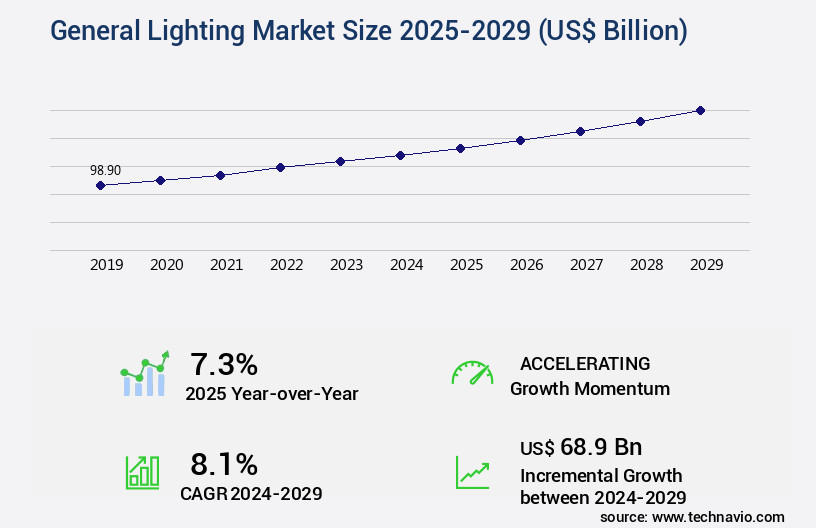
Get Key Insights on Market Forecast (PDF) Request Free Sample
How is the General Lighting Market Segmented and what are the key trends of market segmentation?
The general lighting industry research report provides comprehensive data (region-wise segment analysis), with forecasts and estimates in "USD billion" for the period 2025-2029, as well as historical data from 2019-2023 for the following segments.
- Product
- LED lighting
- Traditional lighting
- Application
- Residential
- Commercial
- Outdoor
- Industrial
- Others
- Geography
- North America
- Europe
- APAC
- Australia
- China
- India
- Japan
- South Korea
- Rest of World (ROW)
By Product Insights
The led lighting segment is estimated to witness significant growth during the forecast period.
The market is witnessing significant advancements, driven by the increasing adoption of energy-efficient LED technology. Currently, LED lighting holds a market share of approximately 35% and is projected to expand further. Traditional lighting sources, such as Compact Fluorescent Lamps (CFLs), Lighting Fluorescent Lamps (LFLs), and High-Intensity Discharge (HID) lamps, are gradually being replaced due to their high power consumption and inadequate energy efficiency. In terms of future growth, the market is expected to expand by around 25% in the next five years. This expansion is primarily driven by the increasing demand for energy-efficient lighting solutions, advancements in driver technology, and the integration of smart lighting systems.
Photometric testing, thermal management, and spectral power distribution are crucial factors influencing the market's evolution. Power factor correction, IES data, and lighting simulation software are essential components of modern lighting infrastructure. Digital lighting control, optical design, daylight harvesting, and illuminance levels are increasingly being adopted to optimize energy efficiency and enhance lighting quality. Human-centric lighting, integrated lighting, and zoning strategies are also gaining popularity in various sectors. Light pollution reduction is another significant trend, as businesses aim to minimize their environmental impact. Energy efficiency standards, such as Energy Star rating, are driving the market's growth. The color temperature, color rendering index, and efficacy measurements are essential factors influencing the adoption of LED technology in various applications.
In the retail sector, task lighting and accent lighting are increasingly being used to create an optimal shopping experience. In the industrial sector, high illuminance levels are required for safety and productivity. In the office sector, ambient lighting is essential for creating a comfortable work environment. The lighting market is a dynamic and evolving industry, with ongoing advancements in technology and changing market trends. The integration of IoT and AI in lighting systems is expected to further revolutionize the market. Despite these advancements, fixture lifespan and cost-effectiveness remain crucial factors influencing market growth.
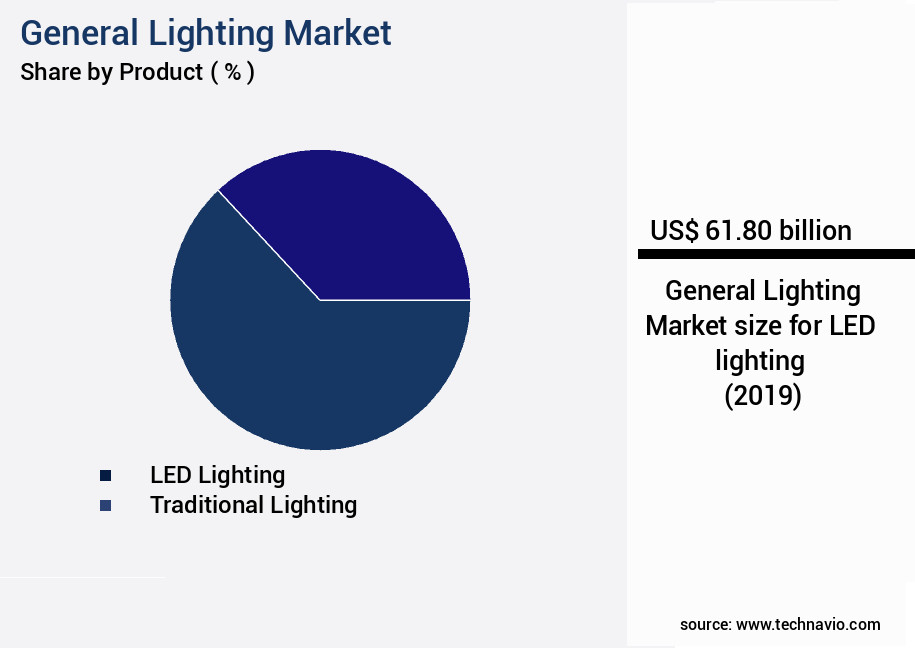
Request Free Sample
The LED lighting segment was valued at USD 61.80 billion in 2019 and showed a gradual increase during the forecast period.
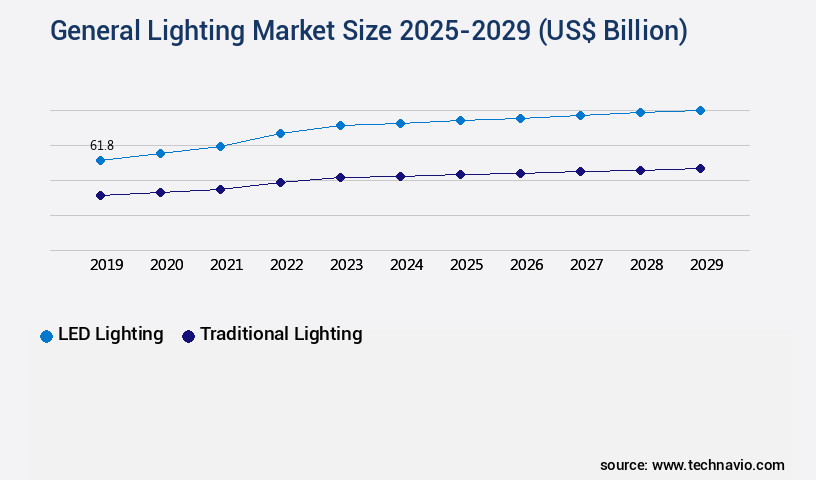
Request Free Sample
Regional Analysis
APAC is estimated to contribute 44% to the growth of the global market during the forecast period.Technavio’s analysts have elaborately explained the regional trends and drivers that shape the market during the forecast period.
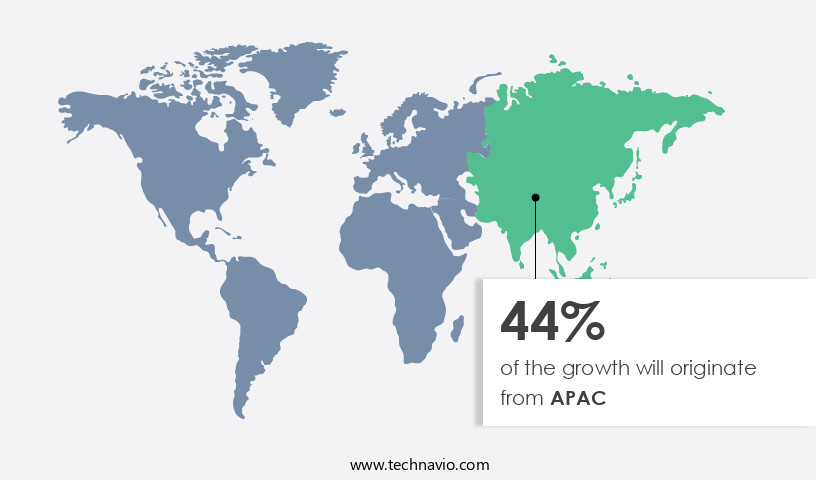
See How General Lighting Market Demand is Rising in APAC Request Free Sample
The market in APAC is experiencing significant expansion, driven by increasing demand from residential and commercial sectors. APAC is a burgeoning hub for industries like retail, hospitality, and healthcare, leading to increased office setup by multinational companies. Urbanization and IT infrastructure growth in countries such as India, China, Japan, and others are fueling the development of smart infrastructure, further increasing the need for energy-efficient lighting solutions.
Moreover, international events in developing countries like China and India during the forecast period will boost market growth. The region's lighting market is witnessing substantial advancements, with a focus on innovation and energy efficiency.
Market Dynamics
Our researchers analyzed the data with 2024 as the base year, along with the key drivers, trends, and challenges. A holistic analysis of drivers will help companies refine their marketing strategies to gain a competitive advantage.
The market is experiencing significant growth due to the increasing demand for energy-efficient and technologically advanced lighting solutions. One key area of focus is the thermal performance of LED luminaires, which is crucial for ensuring long-term reliability and reducing energy consumption. In high-bay applications, the efficacy of LED lighting is outpacing traditional technologies, offering up to 150 lumens per watt compared to 100 lumens per watt for high-intensity discharge (HID) lamps. In low-bay settings, energy savings calculations show LED lighting can save up to 75% compared to incandescent bulbs. Smart lighting system integration protocols, such as DALI and Zigbee, enable seamless communication between various lighting components and allow for advanced control features like daylight harvesting system design considerations and lighting control system dimming curve optimization.
Photometric modeling for street lighting and human-centric lighting design guidelines are essential for ensuring optimal visual comfort and energy efficiency in outdoor and indoor environments, respectively. Visual comfort probability calculation methods and color rendering index impact on visual perception are critical factors in creating high-quality lighting designs. Energy-efficient lighting fixture selection guides and dynamic lighting control strategies implementation are essential for reducing residential lighting energy consumption. Commercial lighting fixture lifespan estimation and integrated lighting system performance evaluation are crucial for maximizing return on investment. Occupancy-based lighting control system deployment and lighting design for optimal glare reduction are essential for creating comfortable and energy-efficient workspaces.
Advanced lighting control systems feature real-time energy monitoring, wireless connectivity, and customizable dimming and color temperature settings. A comparative analysis of lighting simulation software reveals Luminaire Grid and Relux offering the most comprehensive features and accurate results, making them preferred choices for professionals in the lighting industry. By implementing these advanced lighting solutions, businesses can significantly reduce energy consumption, enhance visual comfort, and improve overall operational efficiency.
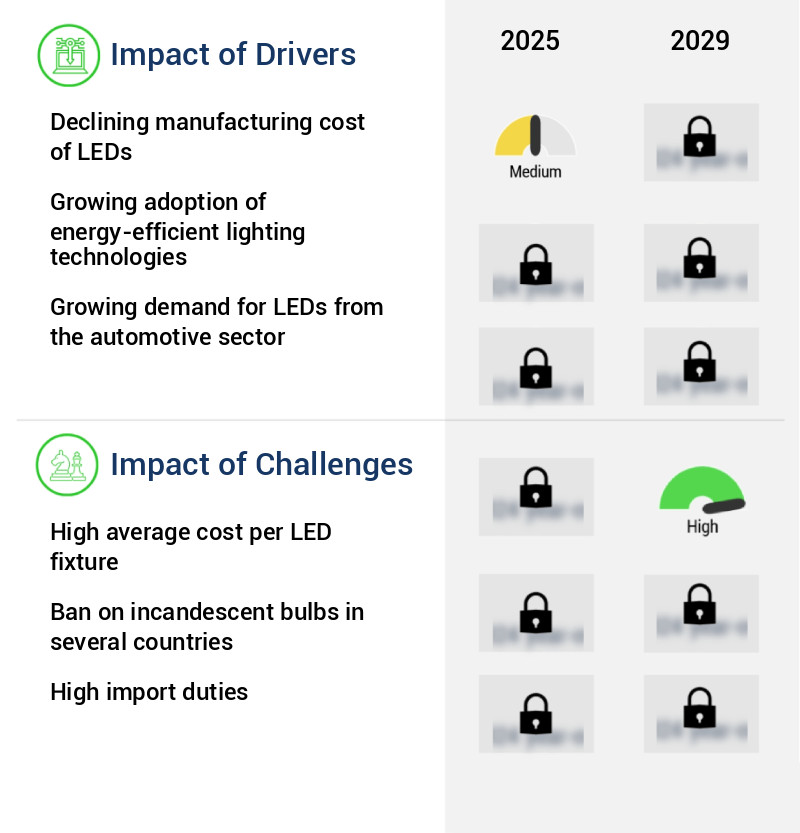
What are the key market drivers leading to the rise in the adoption of General Lighting Industry?
- The decreasing manufacturing costs of LEDs serve as the primary catalyst for market growth in this sector.
- LED production costs have experienced significant reductions over the last decade, a trend that is expected to persist throughout the forecast period. This decline is primarily attributed to the decreasing Average Selling Prices (ASPs) of chips and components utilized in LED manufacturing. The falling production costs have resulted in a decrease in the initial investment required for LED lighting and fixtures, thereby driving the installation of new LED lamps and fixtures across various sectors. Government subsidies for the acquisition of semiconductor equipment, such as metal-organic chemical vapor deposition (MOCVD), have played a crucial role in reducing LED production costs.
- MOCVD is a critical technology used in the production of LEDs. Consequently, LED manufacturers have expanded their production capacity to meet the increasing demand for energy-efficient lighting solutions. In summary, the continuous decline in LED production costs is a significant factor driving the adoption of LED lighting and fixtures across various applications. This trend is expected to continue, providing businesses with cost-effective and energy-efficient lighting options.
What are the market trends shaping the General Lighting Industry?
- The trend in market consumption is shifting towards an increasing number of households and urbanization. Urbanization and the growth of households represent the emerging market trend.
- Urbanization, a global phenomenon, significantly influences the demand for lighting systems, particularly in the residential sector. With an increasing number of households being formed worldwide, the installation of new lamps and luminaires becomes necessary. This trend is expected to result in a surge in unit shipments and revenue for general lighting products. The Chinese market, in particular, is poised for substantial growth due to the rising demand for luxury homes and high-end residential communities. This trend is anticipated to fuel the adoption of advanced lighting technologies like LED lamps and luminaires.
- The expansion of urban areas and the subsequent increase in household formation are key factors driving the growth of the lighting market. This dynamic market is characterized by the continuous adoption of innovative technologies and the evolving preferences of consumers. The global lighting market is a significant business domain, undergoing continuous change and offering numerous opportunities for stakeholders.
What challenges does the General Lighting Industry face during its growth?
- The high average cost of LED fixtures poses a significant challenge to the industry's growth trajectory.
- The global smart lighting market is experiencing significant growth, driven by the increasing adoption of energy-efficient LED technology and the integration of Internet of Things (IoT) infrastructure. According to recent market research, the global smart lighting market is projected to reach a value of USD58.4 billion by 2025, growing at a steady pace. However, the high initial cost of LED luminaires and IoT infrastructure remains a barrier to entry for some consumers. The price of LED luminaires varies, with some manufacturers offering products in the range of USD15 to USD180. This price disparity can hinder the expansion of the smart lighting market during the forecast period.
- Despite the initial investment, the long-term savings from energy efficiency and advanced features make smart lighting an attractive option for businesses and homeowners alike. The market's continuous evolution includes the development of new technologies, such as wireless connectivity and voice control, which are expected to further drive demand.
Exclusive Customer Landscape
The general lighting market forecasting report includes the adoption lifecycle of the market, covering from the innovator’s stage to the laggard’s stage. It focuses on adoption rates in different regions based on penetration. Furthermore, the general lighting market report also includes key purchase criteria and drivers of price sensitivity to help companies evaluate and develop their market growth analysis strategies.
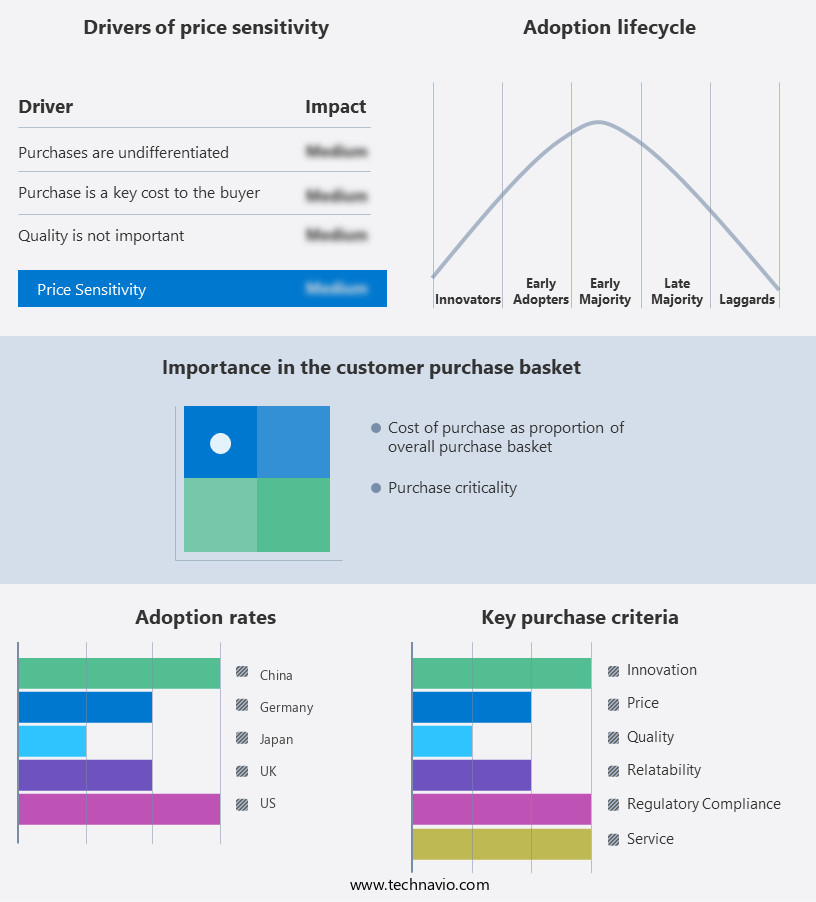
Customer Landscape of General Lighting Industry
Competitive Landscape & Market Insights
Companies are implementing various strategies, such as strategic alliances, general lighting market forecast, partnerships, mergers and acquisitions, geographical expansion, and product/service launches, to enhance their presence in the industry.
Acuity Brands Inc. - This company specializes in providing innovative lighting solutions, encompassing horticulture and lighting control systems. Through advanced technology and research, they deliver efficient and effective lighting options for various applications.
The industry research and growth report includes detailed analyses of the competitive landscape of the market and information about key companies, including:
- Acuity Brands Inc.
- Advanced Lighting Technologies LLC
- Bridgelux Inc.
- Citizen Watch Co. of America Inc.
- Cree Lighting
- Delta Electronics Inc.
- Dialight PLC
- Eaton Corp. plc
- General Electric Co.
- Hafele America Co.
- Hubbell Inc.
- Koninklijke Philips N.V.
- Lumens Co. Ltd.
- OSRAM GmbH
- Panasonic Holdings Corp.
- Schneider Electric SE
- Selux AG
- Signify NV
- Wipro Ltd.
- Zumtobel Group AG
Qualitative and quantitative analysis of companies has been conducted to help clients understand the wider business environment as well as the strengths and weaknesses of key industry players. Data is qualitatively analyzed to categorize companies as pure play, category-focused, industry-focused, and diversified; it is quantitatively analyzed to categorize companies as dominant, leading, strong, tentative, and weak.
Recent Development and News in General Lighting Market
- In January 2024, Philips Hue, a leading player in the market, introduced the latest addition to its smart lighting portfolio - the Philips Hue Play HDMI Sync Box (Reuters, 2024). This innovative device synchronizes Philips Hue lights with the content displayed on a TV screen, enhancing the viewing experience.
- In March 2024, Osram and Signify, two major players in the market, announced a strategic collaboration to jointly develop and commercialize horticultural lighting solutions (Wall Street Journal, 2024). This partnership aims to address the growing demand for energy-efficient horticultural lighting in the agriculture industry.
- In May 2024, Cree, Inc., a US-based lighting company, completed the acquisition of Lightrider, a leading provider of intelligent LED lighting systems for commercial applications (Business Wire, 2024). This acquisition expanded Cree's portfolio and strengthened its position in the commercial lighting market.
- In February 2025, the European Union passed the new Energy Performance of Buildings Directive (EPBD), mandating the installation of energy-efficient lighting systems in all new and existing buildings by 2030 (European Parliament, 2025). This regulatory approval is expected to significantly boost the demand for energy-efficient lighting solutions in Europe.
Dive into Technavio’s robust research methodology, blending expert interviews, extensive data synthesis, and validated models for unparalleled General Lighting Market insights. See full methodology.
|
Market Scope
|
|
Report Coverage
|
Details
|
|
Page number
|
206
|
|
Base year
|
2024
|
|
Historic period
|
2019-2023 |
|
Forecast period
|
2025-2029
|
|
Growth momentum & CAGR
|
Accelerate at a CAGR of 8.1%
|
|
Market growth 2025-2029
|
USD 68.9 billion
|
|
Market structure
|
Fragmented
|
|
YoY growth 2024-2025(%)
|
7.3
|
|
Key countries
|
US, China, Japan, Germany, UK, India, South Korea, Canada, Australia, and France
|
|
Competitive landscape
|
Leading Companies, Market Positioning of Companies, Competitive Strategies, and Industry Risks
|
Request Free Sample
Research Analyst Overview
- The dynamic the market is characterized by the continuous evolution of technologies and trends, with Light Emitting Diodes (LED) leading the charge. LED lighting offers significant advantages in terms of power consumption and intensity, making it an increasingly popular choice for various applications. Power consumption is a critical factor in the lighting industry, and LED technology significantly outperforms traditional lighting methods. According to industry data, LEDs consume up to 80% less power than incandescent bulbs, resulting in substantial energy savings. Another essential consideration is light intensity, which is measured in luminous flux. LEDs offer high luminous flux, ensuring adequate illumination while reducing the need for multiple fixtures.
- Moreover, LEDs' energy star rating is a key factor in their growing adoption, as energy efficiency standards become increasingly stringent. Driver technology, thermal management, and spectral power distribution are other essential aspects of the LED market. Remote monitoring and digital lighting control systems have gained popularity due to their ability to optimize energy usage and improve overall efficiency. Moreover, human centric lighting, integrated lighting, and smart lighting systems are emerging trends in the market. These systems focus on providing optimal lighting conditions for various tasks and environments, enhancing user comfort and productivity. LED technology's advancements extend to lighting infrastructure, with improvements in optical design, color temperature, and fixture lifespan.
- Lighting simulation software enables designers to visualize and optimize lighting solutions, ensuring accurate and efficient implementation. Energy efficiency standards continue to evolve, driving the need for power factor correction and daylight harvesting strategies. Illuminance levels, color rendering index, and efficacy measurements are essential metrics in evaluating the performance of various lighting solutions. Zoning strategies and light pollution reduction are other areas of focus in the lighting market, as businesses and consumers seek to optimize energy usage and minimize environmental impact. Overall, the market is a dynamic and evolving landscape, with LED technology driving innovation and efficiency.
What are the Key Data Covered in this General Lighting Market Research and Growth Report?
-
What is the expected growth of the General Lighting Market between 2025 and 2029?
-
What segmentation does the market report cover?
-
The report segmented by Product (LED lighting and Traditional lighting), Application (Residential, Commercial, Outdoor, Industrial, and Others), and Geography (APAC, Europe, North America, Middle East and Africa, and South America)
-
Which regions are analyzed in the report?
-
APAC, Europe, North America, Middle East and Africa, and South America
-
What are the key growth drivers and market challenges?
-
Who are the major players in the General Lighting Market?
-
Key Companies Acuity Brands Inc., Advanced Lighting Technologies LLC, Bridgelux Inc., Citizen Watch Co. of America Inc., Cree Lighting, Delta Electronics Inc., Dialight PLC, Eaton Corp. plc, General Electric Co., Hafele America Co., Hubbell Inc., Koninklijke Philips N.V., Lumens Co. Ltd., OSRAM GmbH, Panasonic Holdings Corp., Schneider Electric SE, Selux AG, Signify NV, Wipro Ltd., and Zumtobel Group AG
Market Research Insights
- The market encompasses a diverse range of applications, including interior and exterior lighting, color consistency, and decorative installations. According to industry estimates, the global market for lighting solutions is projected to reach USD100 billion by 2025, growing at a compound annual growth rate of 5%. Exterior lighting applications, such as street and tunnel lighting, account for approximately 30% of the total market share. In contrast, interior lighting, including office, retail, and architectural installations, represents around 70% of the market. Energy auditing, lighting calculations, and daylight modeling are essential considerations in modern lighting design, driving the adoption of advanced technologies like remote diagnostics, control protocols, and network connectivity.
- Light trespass, glare control, and uniformity metrics are crucial factors in ensuring visual comfort and energy efficiency. Industrial and emergency lighting applications demand high-performance fixtures, while fixture selection criteria may vary based on specific project requirements. Emerging trends in lighting include the integration of data analytics platforms, energy management systems, and occupancy sensing capabilities. These advancements enable more effective lighting maintenance and scheduling, contributing to the ongoing evolution of the lighting market.
We can help! Our analysts can customize this general lighting market research report to meet your requirements.
Get in touch
1 Executive Summary
- 1.1 Market overview
- Executive Summary - Chart on Market Overview
- Executive Summary - Data Table on Market Overview
- Executive Summary - Chart on Global Market Characteristics
- Executive Summary - Chart on Market by Geography
- Executive Summary - Chart on Market Segmentation by Product
- Executive Summary - Chart on Market Segmentation by Application
- Executive Summary - Chart on Incremental Growth
- Executive Summary - Data Table on Incremental Growth
- Executive Summary - Chart on Company Market Positioning
2 Technavio Analysis
- 2.1 Analysis of price sensitivity, lifecycle, customer purchase basket, adoption rates, and purchase criteria
- Analysis of price sensitivity, lifecycle, customer purchase basket, adoption rates, and purchase criteria
- 2.2 Criticality of inputs and Factors of differentiation
- Overview on criticality of inputs and factors of differentiation
- 2.3 Factors of disruption
- Overview on factors of disruption
- 2.4 Impact of drivers and challenges
- Impact of drivers and challenges in 2024 and 2029
3 Market Landscape
- 3.1 Market ecosystem
- Parent Market
- Data Table on - Parent Market
- 3.2 Market characteristics
- Market characteristics analysis
4 Market Sizing
- 4.1 Market definition
- Offerings of companies included in the market definition
- 4.2 Market segment analysis
- 4.4 Market outlook: Forecast for 2024-2029
- Chart on Global - Market size and forecast 2024-2029 ($ billion)
- Data Table on Global - Market size and forecast 2024-2029 ($ billion)
- Chart on Global Market: Year-over-year growth 2024-2029 (%)
- Data Table on Global Market: Year-over-year growth 2024-2029 (%)
5 Historic Market Size
- 5.1 Global General Lighting Market 2019 - 2023
- Historic Market Size - Data Table on Global General Lighting Market 2019 - 2023 ($ billion)
- 5.2 Product segment analysis 2019 - 2023
- Historic Market Size - Product Segment 2019 - 2023 ($ billion)
- 5.3 Application segment analysis 2019 - 2023
- Historic Market Size - Application Segment 2019 - 2023 ($ billion)
- 5.4 Geography segment analysis 2019 - 2023
- Historic Market Size - Geography Segment 2019 - 2023 ($ billion)
- 5.5 Country segment analysis 2019 - 2023
- Historic Market Size - Country Segment 2019 - 2023 ($ billion)
6 Qualitative Analysis
- 6.1 Impact of AI in global general lighting market
7 Five Forces Analysis
- 7.1 Five forces summary
- Five forces analysis - Comparison between 2024 and 2029
- 7.2 Bargaining power of buyers
- Bargaining power of buyers - Impact of key factors 2024 and 2029
- 7.3 Bargaining power of suppliers
- Bargaining power of suppliers - Impact of key factors in 2024 and 2029
- 7.4 Threat of new entrants
- Threat of new entrants - Impact of key factors in 2024 and 2029
- 7.5 Threat of substitutes
- Threat of substitutes - Impact of key factors in 2024 and 2029
- 7.6 Threat of rivalry
- Threat of rivalry - Impact of key factors in 2024 and 2029
- 7.7 Market condition
- Chart on Market condition - Five forces 2024 and 2029
8 Market Segmentation by Product
- 8.1 Market segments
- Chart on Product - Market share 2024-2029 (%)
- Data Table on Product - Market share 2024-2029 (%)
- 8.2 Comparison by Product
- Chart on Comparison by Product
- Data Table on Comparison by Product
- 8.3 LED lighting - Market size and forecast 2024-2029
- Chart on LED lighting - Market size and forecast 2024-2029 ($ billion)
- Data Table on LED lighting - Market size and forecast 2024-2029 ($ billion)
- Chart on LED lighting - Year-over-year growth 2024-2029 (%)
- Data Table on LED lighting - Year-over-year growth 2024-2029 (%)
- 8.4 Traditional lighting - Market size and forecast 2024-2029
- Chart on Traditional lighting - Market size and forecast 2024-2029 ($ billion)
- Data Table on Traditional lighting - Market size and forecast 2024-2029 ($ billion)
- Chart on Traditional lighting - Year-over-year growth 2024-2029 (%)
- Data Table on Traditional lighting - Year-over-year growth 2024-2029 (%)
- 8.5 Market opportunity by Product
- Market opportunity by Product ($ billion)
- Data Table on Market opportunity by Product ($ billion)
9 Market Segmentation by Application
- 9.1 Market segments
- Chart on Application - Market share 2024-2029 (%)
- Data Table on Application - Market share 2024-2029 (%)
- 9.2 Comparison by Application
- Chart on Comparison by Application
- Data Table on Comparison by Application
- 9.3 Residential - Market size and forecast 2024-2029
- Chart on Residential - Market size and forecast 2024-2029 ($ billion)
- Data Table on Residential - Market size and forecast 2024-2029 ($ billion)
- Chart on Residential - Year-over-year growth 2024-2029 (%)
- Data Table on Residential - Year-over-year growth 2024-2029 (%)
- 9.4 Commercial - Market size and forecast 2024-2029
- Chart on Commercial - Market size and forecast 2024-2029 ($ billion)
- Data Table on Commercial - Market size and forecast 2024-2029 ($ billion)
- Chart on Commercial - Year-over-year growth 2024-2029 (%)
- Data Table on Commercial - Year-over-year growth 2024-2029 (%)
- 9.5 Outdoor - Market size and forecast 2024-2029
- Chart on Outdoor - Market size and forecast 2024-2029 ($ billion)
- Data Table on Outdoor - Market size and forecast 2024-2029 ($ billion)
- Chart on Outdoor - Year-over-year growth 2024-2029 (%)
- Data Table on Outdoor - Year-over-year growth 2024-2029 (%)
- 9.6 Industrial - Market size and forecast 2024-2029
- Chart on Industrial - Market size and forecast 2024-2029 ($ billion)
- Data Table on Industrial - Market size and forecast 2024-2029 ($ billion)
- Chart on Industrial - Year-over-year growth 2024-2029 (%)
- Data Table on Industrial - Year-over-year growth 2024-2029 (%)
- 9.7 Others - Market size and forecast 2024-2029
- Chart on Others - Market size and forecast 2024-2029 ($ billion)
- Data Table on Others - Market size and forecast 2024-2029 ($ billion)
- Chart on Others - Year-over-year growth 2024-2029 (%)
- Data Table on Others - Year-over-year growth 2024-2029 (%)
- 9.8 Market opportunity by Application
- Market opportunity by Application ($ billion)
- Data Table on Market opportunity by Application ($ billion)
10 Customer Landscape
- 10.1 Customer landscape overview
- Analysis of price sensitivity, lifecycle, customer purchase basket, adoption rates, and purchase criteria
11 Geographic Landscape
- 11.1 Geographic segmentation
- Chart on Market share by geography 2024-2029 (%)
- Data Table on Market share by geography 2024-2029 (%)
- 11.2 Geographic comparison
- Chart on Geographic comparison
- Data Table on Geographic comparison
- 11.3 APAC - Market size and forecast 2024-2029
- Chart on APAC - Market size and forecast 2024-2029 ($ billion)
- Data Table on APAC - Market size and forecast 2024-2029 ($ billion)
- Chart on APAC - Year-over-year growth 2024-2029 (%)
- Data Table on APAC - Year-over-year growth 2024-2029 (%)
- 11.4 Europe - Market size and forecast 2024-2029
- Chart on Europe - Market size and forecast 2024-2029 ($ billion)
- Data Table on Europe - Market size and forecast 2024-2029 ($ billion)
- Chart on Europe - Year-over-year growth 2024-2029 (%)
- Data Table on Europe - Year-over-year growth 2024-2029 (%)
- 11.5 North America - Market size and forecast 2024-2029
- Chart on North America - Market size and forecast 2024-2029 ($ billion)
- Data Table on North America - Market size and forecast 2024-2029 ($ billion)
- Chart on North America - Year-over-year growth 2024-2029 (%)
- Data Table on North America - Year-over-year growth 2024-2029 (%)
- 11.6 Middle East and Africa - Market size and forecast 2024-2029
- Chart on Middle East and Africa - Market size and forecast 2024-2029 ($ billion)
- Data Table on Middle East and Africa - Market size and forecast 2024-2029 ($ billion)
- Chart on Middle East and Africa - Year-over-year growth 2024-2029 (%)
- Data Table on Middle East and Africa - Year-over-year growth 2024-2029 (%)
- 11.7 South America - Market size and forecast 2024-2029
- Chart on South America - Market size and forecast 2024-2029 ($ billion)
- Data Table on South America - Market size and forecast 2024-2029 ($ billion)
- Chart on South America - Year-over-year growth 2024-2029 (%)
- Data Table on South America - Year-over-year growth 2024-2029 (%)
- 11.8 US - Market size and forecast 2024-2029
- Chart on US - Market size and forecast 2024-2029 ($ billion)
- Data Table on US - Market size and forecast 2024-2029 ($ billion)
- Chart on US - Year-over-year growth 2024-2029 (%)
- Data Table on US - Year-over-year growth 2024-2029 (%)
- 11.9 China - Market size and forecast 2024-2029
- Chart on China - Market size and forecast 2024-2029 ($ billion)
- Data Table on China - Market size and forecast 2024-2029 ($ billion)
- Chart on China - Year-over-year growth 2024-2029 (%)
- Data Table on China - Year-over-year growth 2024-2029 (%)
- 11.10 Japan - Market size and forecast 2024-2029
- Chart on Japan - Market size and forecast 2024-2029 ($ billion)
- Data Table on Japan - Market size and forecast 2024-2029 ($ billion)
- Chart on Japan - Year-over-year growth 2024-2029 (%)
- Data Table on Japan - Year-over-year growth 2024-2029 (%)
- 11.11 Germany - Market size and forecast 2024-2029
- Chart on Germany - Market size and forecast 2024-2029 ($ billion)
- Data Table on Germany - Market size and forecast 2024-2029 ($ billion)
- Chart on Germany - Year-over-year growth 2024-2029 (%)
- Data Table on Germany - Year-over-year growth 2024-2029 (%)
- 11.12 UK - Market size and forecast 2024-2029
- Chart on UK - Market size and forecast 2024-2029 ($ billion)
- Data Table on UK - Market size and forecast 2024-2029 ($ billion)
- Chart on UK - Year-over-year growth 2024-2029 (%)
- Data Table on UK - Year-over-year growth 2024-2029 (%)
- 11.13 India - Market size and forecast 2024-2029
- Chart on India - Market size and forecast 2024-2029 ($ billion)
- Data Table on India - Market size and forecast 2024-2029 ($ billion)
- Chart on India - Year-over-year growth 2024-2029 (%)
- Data Table on India - Year-over-year growth 2024-2029 (%)
- 11.14 South Korea - Market size and forecast 2024-2029
- Chart on South Korea - Market size and forecast 2024-2029 ($ billion)
- Data Table on South Korea - Market size and forecast 2024-2029 ($ billion)
- Chart on South Korea - Year-over-year growth 2024-2029 (%)
- Data Table on South Korea - Year-over-year growth 2024-2029 (%)
- 11.15 Canada - Market size and forecast 2024-2029
- Chart on Canada - Market size and forecast 2024-2029 ($ billion)
- Data Table on Canada - Market size and forecast 2024-2029 ($ billion)
- Chart on Canada - Year-over-year growth 2024-2029 (%)
- Data Table on Canada - Year-over-year growth 2024-2029 (%)
- 11.16 Australia - Market size and forecast 2024-2029
- Chart on Australia - Market size and forecast 2024-2029 ($ billion)
- Data Table on Australia - Market size and forecast 2024-2029 ($ billion)
- Chart on Australia - Year-over-year growth 2024-2029 (%)
- Data Table on Australia - Year-over-year growth 2024-2029 (%)
- 11.17 France - Market size and forecast 2024-2029
- Chart on France - Market size and forecast 2024-2029 ($ billion)
- Data Table on France - Market size and forecast 2024-2029 ($ billion)
- Chart on France - Year-over-year growth 2024-2029 (%)
- Data Table on France - Year-over-year growth 2024-2029 (%)
- 11.18 Market opportunity by geography
- Market opportunity by geography ($ billion)
- Data Tables on Market opportunity by geography ($ billion)
12 Drivers, Challenges, and Opportunity/Restraints
- 12.3 Impact of drivers and challenges
- Impact of drivers and challenges in 2024 and 2029
- 12.4 Market opportunities/restraints
13 Competitive Landscape
- 13.2 Competitive Landscape
- Overview on criticality of inputs and factors of differentiation
- 13.3 Landscape disruption
- Overview on factors of disruption
- 13.4 Industry risks
- Impact of key risks on business
14 Competitive Analysis
- 14.2 Company ranking index
- 14.3 Market positioning of companies
- Matrix on companies position and classification
- 14.4 Acuity Brands Inc.
- Acuity Brands Inc. - Overview
- Acuity Brands Inc. - Business segments
- Acuity Brands Inc. - Key offerings
- Acuity Brands Inc. - Segment focus
- SWOT
- 14.5 Advanced Lighting Technologies LLC
- Advanced Lighting Technologies LLC - Overview
- Advanced Lighting Technologies LLC - Product / Service
- Advanced Lighting Technologies LLC - Key offerings
- SWOT
- 14.6 Bridgelux Inc.
- Bridgelux Inc. - Overview
- Bridgelux Inc. - Product / Service
- Bridgelux Inc. - Key offerings
- SWOT
- 14.7 Citizen Watch Co. of America Inc.
- Citizen Watch Co. of America Inc. - Overview
- Citizen Watch Co. of America Inc. - Product / Service
- Citizen Watch Co. of America Inc. - Key offerings
- SWOT
- 14.8 Cree Lighting
- Cree Lighting - Overview
- Cree Lighting - Product / Service
- Cree Lighting - Key offerings
- SWOT
- 14.9 Dialight PLC
- Dialight PLC - Overview
- Dialight PLC - Business segments
- Dialight PLC - Key news
- Dialight PLC - Key offerings
- Dialight PLC - Segment focus
- SWOT
- 14.10 Eaton Corp. plc
- Eaton Corp. plc - Overview
- Eaton Corp. plc - Business segments
- Eaton Corp. plc - Key news
- Eaton Corp. plc - Key offerings
- Eaton Corp. plc - Segment focus
- SWOT
- 14.11 General Electric Co.
- General Electric Co. - Overview
- General Electric Co. - Business segments
- General Electric Co. - Key news
- General Electric Co. - Key offerings
- General Electric Co. - Segment focus
- SWOT
- 14.12 Lumens Co. Ltd.
- Lumens Co. Ltd. - Overview
- Lumens Co. Ltd. - Business segments
- Lumens Co. Ltd. - Key offerings
- Lumens Co. Ltd. - Segment focus
- SWOT
- 14.13 OSRAM GmbH
- OSRAM GmbH - Overview
- OSRAM GmbH - Business segments
- OSRAM GmbH - Key news
- OSRAM GmbH - Key offerings
- OSRAM GmbH - Segment focus
- SWOT
- 14.14 Panasonic Holdings Corp.
- Panasonic Holdings Corp. - Overview
- Panasonic Holdings Corp. - Business segments
- Panasonic Holdings Corp. - Key news
- Panasonic Holdings Corp. - Key offerings
- Panasonic Holdings Corp. - Segment focus
- SWOT
- 14.15 Schneider Electric SE
- Schneider Electric SE - Overview
- Schneider Electric SE - Business segments
- Schneider Electric SE - Key news
- Schneider Electric SE - Key offerings
- Schneider Electric SE - Segment focus
- SWOT
- 14.16 Selux AG
- Selux AG - Overview
- Selux AG - Product / Service
- Selux AG - Key offerings
- SWOT
- 14.17 Signify NV
- Signify NV - Overview
- Signify NV - Business segments
- Signify NV - Key news
- Signify NV - Key offerings
- Signify NV - Segment focus
- SWOT
- 14.18 Zumtobel Group AG
- Zumtobel Group AG - Overview
- Zumtobel Group AG - Business segments
- Zumtobel Group AG - Key offerings
- Zumtobel Group AG - Segment focus
- SWOT
15 Appendix
- 15.2 Inclusions and exclusions checklist
- Inclusions checklist
- Exclusions checklist
- 15.3 Currency conversion rates for US$
- Currency conversion rates for US$
- 15.4 Research methodology
- 15.7 Validation techniques employed for market sizing
- Validation techniques employed for market sizing
- 15.9 360 degree market analysis
- 360 degree market analysis
- 15.10 List of abbreviations







![]() Get the report (PDF) sent to your email within minutes.
Get the report (PDF) sent to your email within minutes.
Complimentary full Excel data with your report purchase.